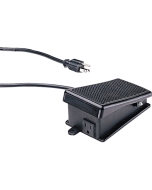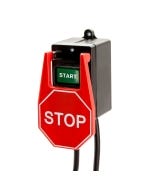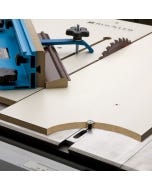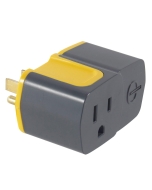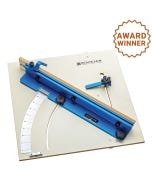Video: Tips for Restocking Safety Gear
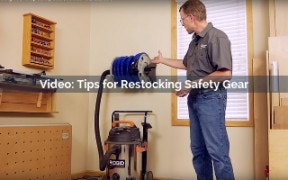
Clean up the clutter and hazards in your shop caused by loose cords, hoses, and cables on the shop floor or benches. The Rockler Ceiling Track System features hooks that keep your cords and hoses off the ground, but roll freely along a ceiling track so you can sand, saw and rout without fighting with them. They can also be used to hang doors for finishing or to hang tools and utility lights.
Skillbuilder Video
Tips for Restocking Safety Gear - Video Transcript
Chris Marshall: For as much as we all love woodworking, it can really take its toll on the body. Breathing in dusty, contaminated shop air can lead to lead to long-term respiratory illnesses. We work with razor-sharp bits and blades that can put our hands in danger. Even moving heavy lumber and sheet goods like this around the shop can lead to back problems. Hi, folks. I'm Chris Marshall with Woodworkers Journal Magazine. I would like to share some products and simple things you can do to improve the air quality in your shop, keep all 10 fingers where they belong, and maybe even avoid the chiropractor. Now, first off is air quality. You already know that woodworking machines like this router table produce a lot of dust. Your best first line of defense is to contain that dust right at the source, by connecting your machines to a dedicated dust collector or a shop vacuum. Building a dust collection system is actually pretty easy these days thanks to starter kits like this one here. It comes with enough blast gates, Y fittings, elbows and hose clamps to hook up several woodworking machine to one dust collector. The only thing that's missing is the four-inch hose or rigid pipe, depending on your preference. Blast gates like these enable you to shut off dust collection to the machines you are not using in order to increase the air pressure to your other connected machines. I think it's a good idea to install a blast gate on the branch lines to your machines as close as possible to the mainline, like this one here. That's particularly important if your dust collector draws under about 1000 cubic feet per minute or if your main line is longer than 10 or 15 feet. Here is another tip, keep these branch lines to your machines as short as possible. It's all about keeping the air moving with as much volume as your system can manage.
Now, not all of us can keep our dust collection systems mounted in the same place all the time. That's especially true if you are work in a small garage shop and you need to move your machines around in order to park a car. Well, Rockler has some helpful products in their Dust Right line-up if you have to connect and disconnect your dust collection system regularly. These quick-connect tool port adapters attach with hose clamps to either four-inch or two and a half-inch ports on your woodworking machines. Then this quick change handle mounts to your dust collector's main hose. Now, just leave it in place and you can plug it into all the quick change fittings on your woodworking machines. It just friction fits in place, so you can bring dust collection to wherever it's needed most.
For most of us, a shop vacuum is at least part of a dust collection system, and it may even be your main way to create a cleaner work environment. You've got to admit, it can be a hassle dragging the shop vac around. Well, if you've ever wished you could just keep the vacuum in one place, Rockler has a solution. This hose reel holds up to 40 feet of vacuum hose so you can work or clean up where you need to and then wind it up when you're through. The best thing is, the vacuum stays in one place, out of your way. Now, air quality is important, but so is keeping hands safe. Here at the table saw, a quality crosscut sled like this will help you make more accurate crosscuts of course, but it offers some safety advantages too. When you're cutting really small workpieces, the sled's fencing base help you keep your fingers a safe distance away. The sled also makes it easier to feed larger workpieces of sheet material or heavier lumber through a cut that would exceed what your saw's miter gauge can handle.
Ripping angled tapered cuts like those on these thin table legs is also pretty common operation. Don't be tempted to make those cuts unless you have a good tapering jig to keep your fingers safe. Now, this jig from Rockler stays automatically aligned with the saw blade because it has an aluminum bar on the back that rides in the saw's miter slot. It's got a pair of sturdy hold down clamps, plus a fence backing up the workpiece. A leg blank can't shift during cutting and invite a kickback accident.
Over here at the router table, this power tool safety switch, is another good safety item to consider adding to your shop. With one of these, you don't have to reach all the way under here to turn your router on and off. it's got a paddle style kill switch on it so you can shut off your router off fast in the event of an emergency. Now, material handling might not seem like a safety issue for woodworking, but lift a few sheets of four by eight plywood, or worse, MDF, and your back might just disagree. They are heavy and bulky. A cart like this, that can help you unload sheet goods and move them around, is awfully helpful and your back will thank you in the long run.
This cart from Rockler is made of steel tubing for strength and it's got large locking casters on it for convenience. I like that the cart can be set to a range of heights to help you adjust it to your truck-bed height. Once you've loaded a sheet onto it, the top can be swiveled to vertical. That makes the cart easier to maneuver through doorways or around other obstacles in the shop. When you are not using it for material handling, this cart can even double as another work table or even an outfeed support device for a bandsaw or other machines. All you have to do is add a worktop to it.
I hope these tips and products help you think more about improving the air quality, general safety and the working conditions in your shop. Thanks for watching.
Keep the inspiration coming!
Subscribe to our newsletter for more woodworking tips and tricks
